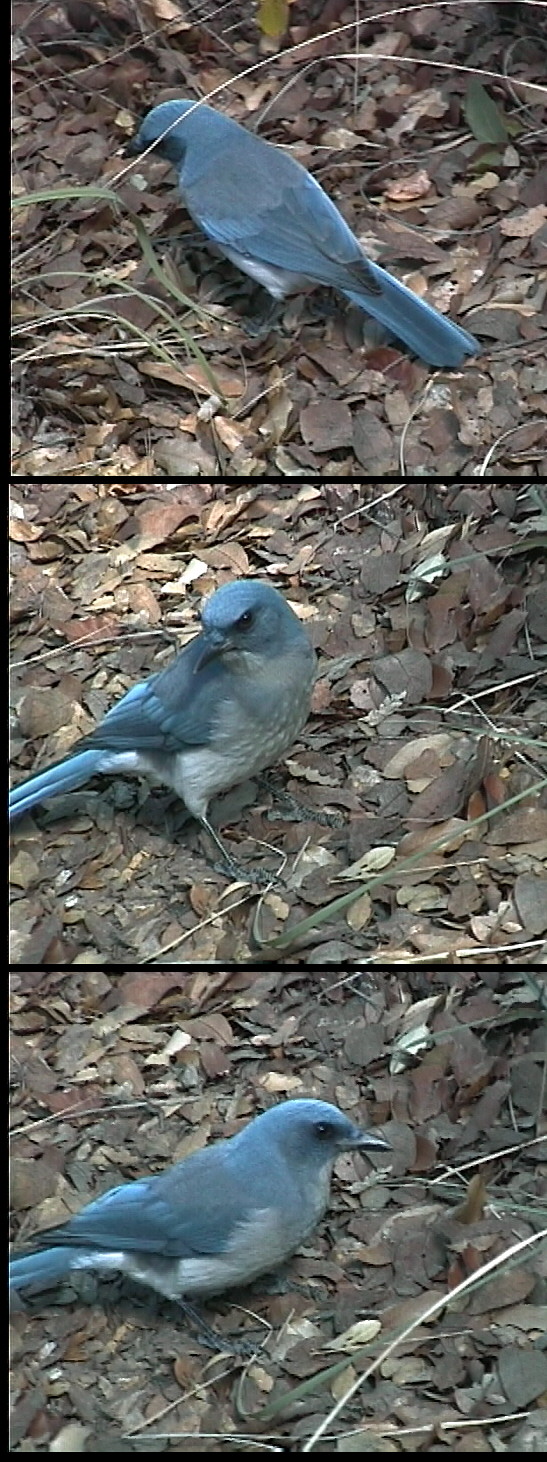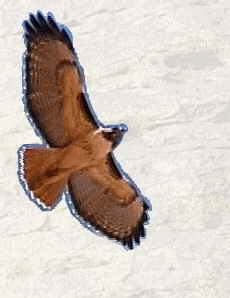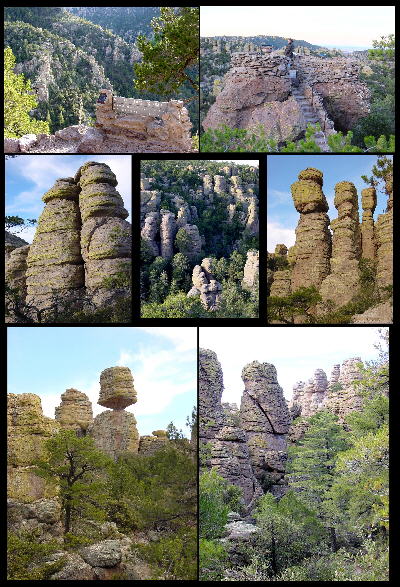
 Now that
the meteor shower was over, it was time to explore
the geological and biological resources of Chiricahua. One uninvited
guest was hard to miss -- the remarkable Mexican Jay. Silent
blue with a touch of dun color on their backs, these resourceful bandits
immediately began using their long beaks to peck open a bag of chocolate-chip
cookies -- almost as though they could read the label. We videotaped
one jay taking bread and hiding bits of it in three different locations,
carefully concealing her cache with a few delicately placed leaves.
(Click here to view the 20 Megabyte
Movie.) Scrub Jays use almost human-like reasoning to remember which
stashes contain the most perishable food, and will actually move hidden food
to different locations if they think they may have been observed.
Click on the picture to enlarge it.
Now that
the meteor shower was over, it was time to explore
the geological and biological resources of Chiricahua. One uninvited
guest was hard to miss -- the remarkable Mexican Jay. Silent
blue with a touch of dun color on their backs, these resourceful bandits
immediately began using their long beaks to peck open a bag of chocolate-chip
cookies -- almost as though they could read the label. We videotaped
one jay taking bread and hiding bits of it in three different locations,
carefully concealing her cache with a few delicately placed leaves.
(Click here to view the 20 Megabyte
Movie.) Scrub Jays use almost human-like reasoning to remember which
stashes contain the most perishable food, and will actually move hidden food
to different locations if they think they may have been observed.
Click on the picture to enlarge it.
(See 1. Clayton and Dickinson,
Episodic-like memory during cache recovery by scrub jays, Nature Vol 395,
17 Sept. 1998 and 2. Emery and Clayton, Effects of experience and social
context on prospective caching strategies by scrub jays, Naure Vol 424, Nov.
2001)
 The cathedral-like rocks have a
strange presence that violates human concepts of scale.
Our ten-mile hike over well-constructed trails was a journey through an enchanted
wonderland of half-recognizable shapes and spaces. (Click here to view the 36
Megabyte Movie.) The park contains several bands of friendly coatamundi,
but we never succeeded in spotting this canny animal. However,
on the morning of our departure, our heavy ice chest was pried open
and a steak devoured -- unobserved by the two exhausted INHL researchers,
shown below. Our goal of photographing the coati
will have to wait until another day. Click and scroll the pictures
to enlarge, or click the hawk to continue.
The cathedral-like rocks have a
strange presence that violates human concepts of scale.
Our ten-mile hike over well-constructed trails was a journey through an enchanted
wonderland of half-recognizable shapes and spaces. (Click here to view the 36
Megabyte Movie.) The park contains several bands of friendly coatamundi,
but we never succeeded in spotting this canny animal. However,
on the morning of our departure, our heavy ice chest was pried open
and a steak devoured -- unobserved by the two exhausted INHL researchers,
shown below. Our goal of photographing the coati
will have to wait until another day. Click and scroll the pictures
to enlarge, or click the hawk to continue.
Click here to Visit Other INHL Destinations

Executive Fellow James Davison, and Executive Director
David F. Etzold
 The cathedral-like rocks have a
strange presence that violates human concepts of scale.
Our ten-mile hike over well-constructed trails was a journey through an enchanted
wonderland of half-recognizable shapes and spaces. (Click here to view the 36
Megabyte Movie.) The park contains several bands of friendly coatamundi,
but we never succeeded in spotting this canny animal. However,
on the morning of our departure, our heavy ice chest was pried open
and a steak devoured -- unobserved by the two exhausted INHL researchers,
shown below. Our goal of photographing the coati
will have to wait until another day. Click and scroll the pictures
to enlarge, or click the hawk to continue.
The cathedral-like rocks have a
strange presence that violates human concepts of scale.
Our ten-mile hike over well-constructed trails was a journey through an enchanted
wonderland of half-recognizable shapes and spaces. (Click here to view the 36
Megabyte Movie.) The park contains several bands of friendly coatamundi,
but we never succeeded in spotting this canny animal. However,
on the morning of our departure, our heavy ice chest was pried open
and a steak devoured -- unobserved by the two exhausted INHL researchers,
shown below. Our goal of photographing the coati
will have to wait until another day. Click and scroll the pictures
to enlarge, or click the hawk to continue.

 Now that
the meteor shower was over, it was time to explore
the geological and biological resources of Chiricahua. One uninvited
guest was hard to miss -- the remarkable Mexican Jay. Silent
blue with a touch of dun color on their backs, these resourceful bandits
immediately began using their long beaks to peck open a bag of chocolate-chip
cookies -- almost as though they could read the label. We videotaped
one jay taking bread and hiding bits of it in three different locations,
carefully concealing her cache with a few delicately placed leaves.
(Click here to view the 20 Megabyte
Movie.) Scrub Jays use almost human-like reasoning to remember which
stashes contain the most perishable food, and will actually move hidden food
to different locations if they think they may have been observed.
Click on the picture to enlarge it.
Now that
the meteor shower was over, it was time to explore
the geological and biological resources of Chiricahua. One uninvited
guest was hard to miss -- the remarkable Mexican Jay. Silent
blue with a touch of dun color on their backs, these resourceful bandits
immediately began using their long beaks to peck open a bag of chocolate-chip
cookies -- almost as though they could read the label. We videotaped
one jay taking bread and hiding bits of it in three different locations,
carefully concealing her cache with a few delicately placed leaves.
(Click here to view the 20 Megabyte
Movie.) Scrub Jays use almost human-like reasoning to remember which
stashes contain the most perishable food, and will actually move hidden food
to different locations if they think they may have been observed.
Click on the picture to enlarge it.
